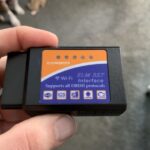Navigating the world of car diagnostics can be confusing, especially with the rise of electric vehicles like Tesla. If you’re wondering, Does Tesla Use Obd2?, the answer is a bit nuanced. While Teslas don’t feature the traditional OBD2 port you might find in gasoline cars, they do offer diagnostic capabilities through a different connector. Let’s delve into the specifics of Tesla diagnostics and how you can access your vehicle’s data.
Tesla’s Diagnostic Port: Not Your Standard OBD2
Instead of the standard OBD2 port, Tesla Model 3 and Model Y vehicles are equipped with a console connector, typically located in the back seat area. This port serves a similar purpose to the OBD2 port in conventional cars – providing access to vehicle diagnostics and data. However, to utilize this port, you’ll need a Tesla OBD2 adapter.
This adapter cable bridges the gap between Tesla’s proprietary connector and standard OBD2 tools. It’s crucial to understand that directly plugging a standard OBD2 scanner into a Tesla without this adapter is not possible and won’t yield any results.
Accessing Tesla Diagnostic Data: What You Need
To tap into your Tesla’s diagnostic data, you’ll need a few key components:
- Tesla OBD2 Adapter: This is the essential link, converting Tesla’s connector to the OBD2 standard. It’s important to choose an adapter that is compatible with your specific Tesla model and year.
- OBD2 Diagnostic Tool: Once you have the adapter, you can connect a standard OBD2 tool or device. For Teslas, it’s recommended to use OBD2 tools that are compatible with ELM327 or STN1110 chipsets. Popular choices among Tesla owners include OBDLink LX or MX Bluetooth devices due to their reliable performance and compatibility with diagnostic apps.
Unlocking Tesla Data: Apps and Capabilities
Connecting to your Tesla’s diagnostic port with the right adapter and tool opens the door to a wealth of live data about your vehicle’s performance and health. However, due to Tesla’s security measures, you primarily gain access to viewing live data rather than modifying critical vehicle functions.
Specialized mobile apps are designed to interpret and display this Tesla-specific data in a user-friendly format. Two of the most popular apps among Tesla owners are:
-
Scan My Tesla App: Available for both Android and iOS, this app provides a comprehensive view of various Tesla statistics, including:
- Battery health: power, voltage, current, temperatures, lifetime stats, capacity estimates.
- Drive Unit performance: electric power, torque, horsepower, RPM, temperatures.
- 12V system monitoring: current, voltage, temperature.
- Trip recording and charging statistics.
- HVAC system readings and controls.
You can see a live demonstration of the Scan My Tesla app in action in this video by Bjørn Nyland:
-
TM-Spy App: Also available on Android and iOS, TM-Spy focuses on detailed battery pack information and other insightful data points:
- Individual cell voltages and battery pack balancing.
- Battery pack temperature sensor readings.
- Total battery voltage and current during driving and charging.
- Pack capacity and remaining energy (kWh).
- Battery pack mileage and lifetime energy statistics.
Explore the TM-Spy app’s capabilities further in this demo video by David Drives Electric:
The Community Behind Tesla Diagnostics
The wealth of data accessible through these apps is largely thanks to the dedicated Tesla community. Enthusiasts have meticulously identified and documented Tesla Model 3’s CAN bus IDs and data parameters, making it possible for these apps to function. You can delve deeper into this community-driven effort in this document.
Special appreciation goes to the Tesla Model 3 community members at Tesla Owners Online for their invaluable contributions to understanding Tesla diagnostics.
In Conclusion
While Tesla vehicles may not have a standard OBD2 port in the traditional sense, they are indeed equipped with diagnostic capabilities. By using a Tesla OBD2 adapter and compatible tools, coupled with powerful apps like Scan My Tesla and TM-Spy, owners can gain valuable insights into their vehicle’s performance and health. This access to data, fueled by community efforts, empowers Tesla owners with greater understanding and control over their electric vehicles.
